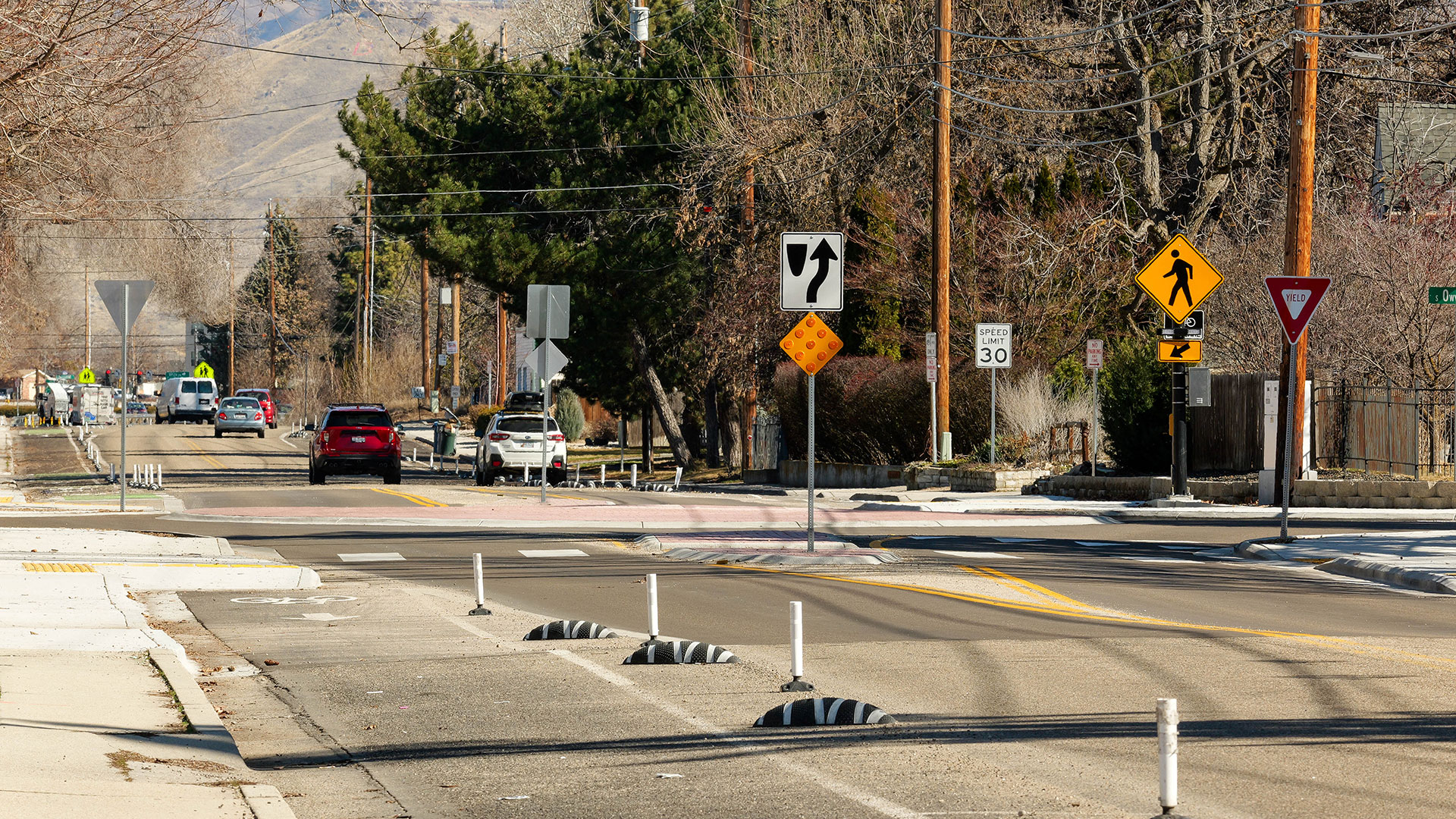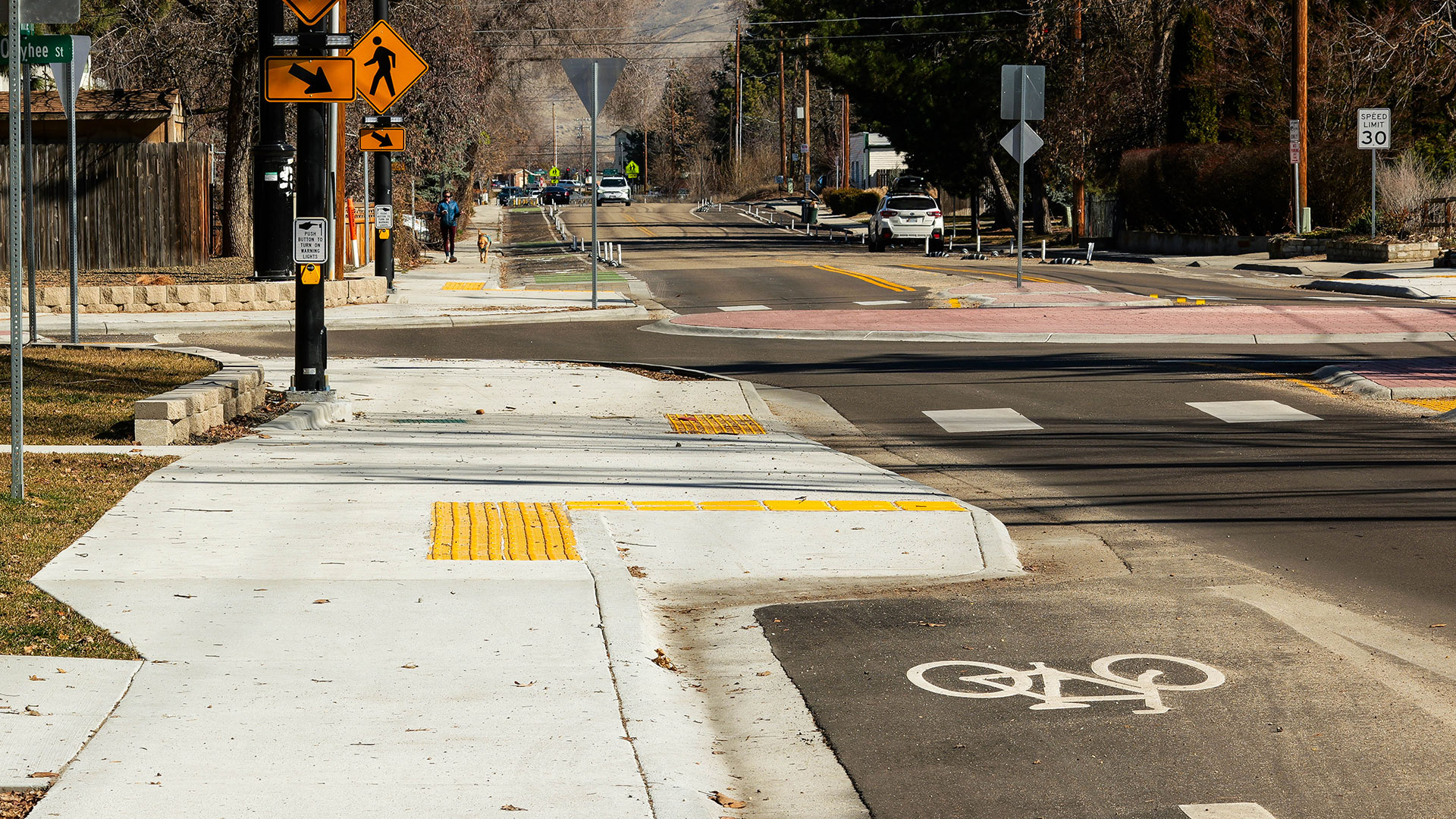June 23, 2025
A Second Set of Eyes Matters More Than You Think
For public agencies tasked with delivering safe, efficient, and publicly supported transportation solutions, the stakes are high—particularly when it comes to roundabouts, an intersection form that tends to elicit strong opinions from the public. A well-designed roundabout can build public trust in addition to reducing conflicts at an intersection, while a poorly executed one can be an unfortunate setback, creating or reinforcing community unease with roundabouts in general.
Spending the time and effort to solicit a roundabout peer review from an experienced designer can be tremendously beneficial for catching issues before they become costly problems. Peer reviews help to ensure a design meets the needs of all users, that the proposed roundabout fits into its unique context, and that the project and process can proceed with confidence. While guidebooks provide a solid foundation for the roundabout designer, they can’t replace the insight that comes from experience. In this article, we explore how peer reviews can help agencies make smarter, safer, and more sustainable roundabout design decisions.

In several cases, we’ve peer reviewed multilane roundabout designs and determined that a single-lane roundabout will provide sufficient capacity for an intersection, leading to a safer and less expensive solution overall.
What Is a Roundabout Peer Review?
A roundabout peer review is an expert evaluation of a roundabout design by a different person or organization than the one designing it. Because roundabouts are still considered newer and more specialized compared to traditional intersections, many agencies and consultants seek input and fresh perspectives on their designs from experienced third-party reviewers who understand the nuances of the task at hand. These reviews can occur at any stage—from conceptual layouts to final construction plans—with earlier reviews offering more opportunity for meaningful improvements.
Roundabout peer reviews take a deeper dive into the performance checks outlined in NCHRP Research Report 1043: Guide for Roundabouts, including fastest paths, truck turning paths, sight distance, view angles, path alignments, and pedestrian accessibility. Depending on the stage, reviews can also get into more of the geometric and constructability details. These reviews help project teams develop designs that are not only technically sound but also context sensitive and accessible for all users.
Benefits of Roundabout Peer Reviews
Why take the extra step to request a roundabout peer review? We believe this practice offers distinct benefits, including:
- Catching issues early. Peer reviews can help identify and resolve design challenges—for example, inadequate truck accommodations—before they become bigger problems. By involving experienced reviewers early in the process, agencies can have more confidence that their designs meet technical specifications while being context sensitive, cost effective, and aligned with best practices as they head into final design.
- Cost savings. Catching issues early means less design rework, which can save time and money over the course of the design process. Peer reviewers can also notice when roundabouts are being overdesigned. In several cases, we’ve peer reviewed multilane roundabout designs and determined that a single-lane roundabout will provide sufficient capacity for an intersection, leading to a safer and less expensive solution overall. Peer reviews can also inform the size and placement of the roundabout, avoiding sensitive areas like private property, utilities, wetlands, or parks.
- Constructability. Roundabouts often replace existing intersections, which means that traffic during construction needs to be accommodated. A peer review can help the project team work through the potential phasing and create a design that reduces impacts to traffic and budgets.
- Consistency. When one consultant, or a small group of them, is on a peer review contract, they can provide a strong understanding of the agency’s context, preferences, and standards. Peer reviews don’t have to happen this way (an experienced peer reviewer can still bring value when they’re unfamiliar with the jurisdiction), but employing a recurring set of peer reviewers can bring needed consistency when a variety of firms are leading the designs.
- Contributing to broader roundabout goals. Spending the time and effort to solicit a peer review that makes sure the final design is effective and easy to navigate not only builds a community’s trust in an individual roundabout, but in roundabouts as a whole. One way to think about a roundabout peer review is “solving problems before they become problems.”

Skilled designers can look at an intersection’s constraints and apply time-tested principles to generate more effective and innovative solutions.
Roundabout Design: A Science and an Art
Beyond technical checks, peer reviewers can bring an eye for layout, composition, and integration with the surrounding environment—balancing the needs of all users, from drivers of large trucks to pedestrians and bicyclists. Early in a career, it’s natural for an engineer to see the process of roundabout design as following steps and checking boxes—and while we advocate leaning on resources like NCHRP 1043 as a technical guide (we wrote it!), there’s also an art to roundabout design that is developed through time and experience.
“If you give 100 people an intersection to redesign, you’ll get 100 different roundabout layouts,” says Senior Principal Engineer Andy Duerr. A roundabout designer faces the challenge of fitting all the pieces together in a way that meets the goals of the intersection and flows naturally in its context. While some differences can be chalked up to preferences, often there are better practices to apply to a design that come with experience. Skilled designers can look at an intersection’s constraints and apply time-tested principles to generate more effective and innovative solutions (highlighting the false dichotomy of “engineer vs. creative”).
“If you give 100 people an intersection to redesign, you’ll get 100 different roundabout layouts."
- Andy Duerr
Design Mentoring
In place of traditional roundabout peer reviews, some states have turned to design mentoring as an even stronger collaboration between roundabout designers and experienced reviewers. Rather than performing peer review checks at specific milestones (after the design team has already put in a lot of work), a design mentor coaches the project team along the way. In addition to achieving better designs and saving money through reducing rework, design mentoring is a powerful way to pass along the knowledge and skill of experienced roundabout designers to the next generation of transportation practitioners, benefiting both organizations and our industry as a result.
Recently, we had the opportunity to work alongside another consulting firm and do exactly that. Andy Duerr and Zach Bugg were initially asked to conduct a traditional peer review, but their involvement shifted to design mentoring and working side by side with the project team when the design proved particularly challenging. Through this collaboration, the project team generated a smaller roundabout design and solved a core vertical issue. The client was happy with the design, and thus with the consulting firm. This is where design mentoring can be a win for everyone! If one of the goals of our work is truly to design safer and better streets for everyone, we must be humble and open enough to allow other organizations to make our work better.
What Makes a Good Roundabout Peer Review
We’ve found the following principles to be important for making the peer review process beneficial to the project team, and thus to the project:
- Get the full picture. You may be eager to jump to the design, but make sure you’re starting from a solid understanding of the situation that may inform you as to why the project team created the design they did. Ask for the operational analysis to understand what triggered the decision to put in a roundabout. Did they perform intersection control evaluation? What other documentation exists detailing the decision? What are key constraints and assumptions that define the challenges and opportunities for improvement?
- Ask questions. Like any good teacher, asking questions, rather than offering critiques, will build collaboration and trust within the project team and keep both parties open to learning and making changes.
- Focus on what’s important. If you hand a project team a 10-page memo with every performance check in the book, the experience is likely going to be more overwhelming than helpful. As much as possible, your recommendations should be succinct, easy to follow, and focused on the most important elements to rethink. You’re not here to “show them up” by commenting on every aspect of the design—this creates insecurity for them, and probably highlights it in you, too!
Continue the Conversation
For agencies aiming to streamline project delivery and enhance the quality of their designs, roundabout peer reviews offer a valuable checkpoint that helps designers meet both technical standards and community needs. If you have questions about setting up a roundabout peer review or design mentoring process, success stories to share, or want to chat about finding a mentor/reviewer for your next project, don’t hesitate to reach out (we might already be a peer reviewer in your state)! We’d be glad to talk further.
